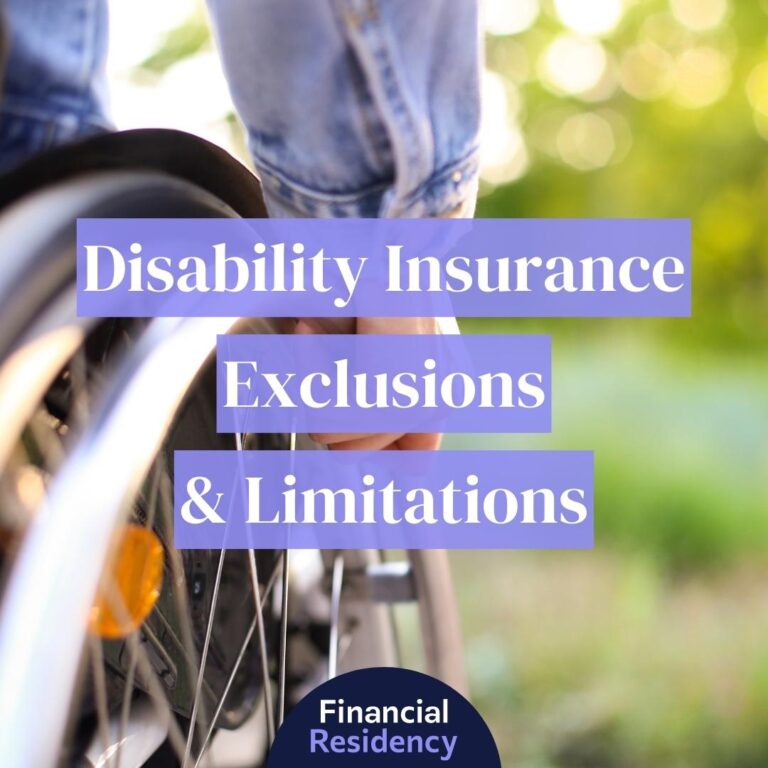Waiting for disability insurance underwriting to be completed can feel like watching water boil. It feels like it takes forever!
What if you don’t have that long? Maybe you want protection now for peace of mind.
Fortunately, no exam disability insurance is an option, with many options for protecting yourself from the financial effects of a disability.
No Exam Disability Insurance: Too Good to Be True?
It sounds like no exam disability insurance is too good to be true, even a scam, but it’s legit. There’s one catch, though.
Many people think of no exam insurance as no underwriting insurance, but that’s not the case. No exam disability insurance is fully underwritten; the insurance company may even pull doctor or other medical records.
The major difference is that you don’t have to take a medical exam.
What is No Exam Disability Insurance?
No exam disability insurance is similar to the disability insurance you’d get with a medical exam policy. Disability insurance pays a percentage of your income if you’re unable to work due to a disability, based on the parameters of your insurance.
How No Exam Disability Insurance Works
Disability insurance pays you a predetermined percentage of your income after you file a claim and the insurance company determines you’re disabled.
You get coverage for the predetermined benefit period, which is often shorter than disability policies with a medical exam.
Qualifying Criteria for No Exam Disability Insurance
The qualifying criteria vary by the insurance company, but you must generally be over 18 years old, have stable employment, and pay your premiums on time.
Some companies have limits to the benefit amount, age, or occupation to qualify for no exam disability insurance.
No matter the type of policy, you must prove your income, but you don’t have to prove things that would require a blood test or medical exam. Some insurance companies don’t even ask about your lifestyle, so you can have dangerous habits and still qualify, but again, it varies by insurance company.
5 Main Types of No Exam Disability Insurance
No exam disability insurance comes in many forms. Understanding the choices can help you determine which suits your needs the best.
1. Traditional
Traditional no exam disability insurance is identical to standard disability insurance, except you don’t have to undergo a medical exam.
With most carriers, you’ll still complete a medical questionnaire and sign authorizations for the underwriter to check your medical records.
Your coverage may be lower than a typical disability insurance policy, so always read the fine print to ensure you’re getting enough coverage. In most cases, the earlier you buy coverage, the more you can get, and vice versa.
This type of disability insurance works best for people looking to supplement a group policy or get extra coverage but don’t need a high benefit amount.
Traditional No Exam DI Example
Traditional no exam disability insurance usually has limits based on age. So, for example, if you are 30 years old and want a no exam disability policy, you may be able to secure up to $5,000 in monthly coverage. However, the same insurance company limits people over 40 to a monthly payout of $3,000.
2. Simplified
A simplified issue policy takes the traditional no exam disability insurance up a notch. Not only do you not need a medical exam, the entire process is simplified.
This means the application process is less intense, you don’t have to provide access to your medical records, and you also don’t need to provide financial records. The most work you do for this policy is a phone interview before approval.
However, there are a couple of downsides.
First, there are fewer benefits, including a lower benefit amount and fewer options to add riders. Second, many insurance companies have two classes – a professional and a blue-collar class. This means everyone is lumped into one of two categories which could mean much higher premiums on top of what’s already a higher premium for the lack of medical exams and underwriting.
Be careful when choosing this option because some companies don’t have any occupation classes, which means everyone is in the same category, resulting in much higher premiums than you’d pay if the classifications were narrower.
Simplified No Exam DI Example
Simplified no exam disability insurance isn’t for everyone. However, it may be beneficial if you only need a small amount of coverage and can find a policy without excessive premiums.
For example, if you have a policy at work but worry that it’s insufficient and you can’t wait for the full underwriting and medical exam process, you may consider a simplified policy. Just ensure it doesn’t exclude workplace injuries or lump everyone into the same occupational category, causing excessive premiums.
3. Guaranteed
Guaranteed standard issue disability insurance (GSI) is similar to group disability insurance with one major difference — it’s portable. This means even if you change jobs, you keep your insurance.
However, unlike traditional or simplified no exam disability insurance, you can only get guaranteed standard issue disability insurance through your employer. But this has its benefits.
You can get coverage similar to a simplified policy, meaning no underwriting or medical exams, but you may get lower premiums because it’s on a group basis. Most GSI policies also figure your income with bonuses or other eligible income, not just your base pay.
Your employer can decide how they’ll handle premiums. Some employers pay them as an employee benefit, and others split the cost with employees. Of course, if you leave your job and keep the policy, you’d be responsible for the payments.
Guaranteed No Exam DI Example
Your employer must opt-in to a guaranteed standard-issue disability insurance policy. It’s not a policy you can pick up yourself.
For example, you start a job with a new practice, and one of the benefits they offer is GSI. They can offer it with attractive premiums because they have the perfect mix of male and female employees, all under 50, with high salaries. They also have 50+ employees, which gives them even better rates for their employees.
While you’re employed with the practice, your employer will cover the premiums as a part of your benefits, and you don’t have to worry about underwriting or pre-existing conditions.
4. Group (Employer-Sponsored) Policy
Group disability policies or employer-sponsored policies are also no exam disability insurance policies. If your employer doesn’t offer a policy, you may qualify with a membership organization, such as a labor union or professional organization.
Most employers cover the cost of the premiums, but some split the cost. No matter the situation, the premiums are usually lower than a traditional no exam policy, and there’s no underwriting to worry about.
But there’s a downside.
The coverage amount is usually low for doctors with high salaries. That’s because most policies have a monthly cap, which for most doctors’ wages, doesn’t allow coverage of at least 60% of their income.
Group Policy No Exam DI Example
Group policies are great because there are no underwriting requirements or medical exams. Anyone that works for an eligible employer qualifies.
But, the cap can be detrimental if you’re a doctor with a high salary, and it’s your only policy. For example, your employer offers a group disability policy with a monthly cap of $4,000. You make $12,500 a month, so $4,000 is only 32% of your income. If you don’t have another policy or savings to make up the difference, leading the same lifestyle can be challenging.
5. Supplemental
Supplemental disability insurance is for high-income earners who need more protection than their existing policies offer. They typically apply to people making $250,000 or more per year, as most traditional policies limit what they’ll pay out.
Like simplified issue disability insurance, supplemental policies don’t require a medical exam or extensive underwriting. Instead, you answer simple questions to get covered. Your premiums remain fixed, and you take the policy with you even if you change employers, as it’s not tied to your current employment.
However, one requirement is to have traditional life insurance on a fully underwritten policy to qualify.
Supplemental No Exam DI Example
Supplemental no exam disability insurance is important for high-earning doctors who are still in their younger years and don’t have much money saved to cover their cost of living for many years if they become disabled.
For example, if you make $250,000 a year and your regular disability insurance has a monthly cap of $12,000. You might need more coverage to continue living the lifestyle you’re used to, but you can’t get more coverage from your traditional policy. If you apply for a supplemental policy within 90 days of buying your traditional policy, you can get an additional policy that offers a benefit period of two to three years with a policy length of three to five years.
Exam vs. No Exam Disability Insurance Costs
Disability insurance costs vary based on many factors, including the policy length, elimination period, and coverage length.
No exam policies may have slightly higher premiums because they take a larger risk forgoing the medical exam, but they typically have lower coverage limits, so the premiums may be similar, but the coverage is lower.
FAQs
No exam disability insurance may be the best option for some people. Here are some further questions to consider.
Does Everyone Need Disability Insurance?
Disability insurance isn’t a requirement, but it is highly suggested for everyone. 27% of adults in America are disabled, so your chances of becoming disabled are 1 in 4. Think about the investment you’ve made in your career with your medical school debt and how you’d see a return if you became disabled. Disability insurance is usually the answer.
Does No Exam DI Have the Same Options as Exam DI?
No exam disability insurance often has fewer riders and lower benefit limits than policies requiring a medical exam. This limits the insurance company’s risk while still providing you with disability insurance.
Who Offers the Best No Exam Disability Insurance?
Each disability insurance company offers different benefits. However, Guardian Life offers great supplements and no exam disability insurance to consider.
Is No Exam Disability Insurance Best for You?
No exam disability insurance is a great way to protect your income. While its coverage limits are lower and terms may be shorter, it can be a great supplement, whether you have an employer-sponsored plan or purchase a traditional or simplified disability insurance yourself.



